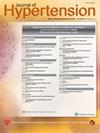[01.01]联合卫生专业人员主导的干预措施改善高血压患者血压控制:cochrane系统综述和荟萃分析
IF 3.3
2区 医学
Q1 PERIPHERAL VASCULAR DISEASE
引用次数: 8
摘要
目的:护士或药剂师主导的护理可改善高血压的控制。我们进行了一项新的Cochrane综述,对联合健康专业人员主导的高血压管理干预措施的证据进行了综述。设计和方法:我们检索了截至2013年10月的多个文献数据库进行随机对照试验。我们纳入了与常规高血压管理相比,旨在改善血压控制的任何护理、药剂师或联合卫生专业人员主导的干预措施。主要观察指标为收缩压的变化、研究目标血压的达到和抗高血压药物的使用。两位作者独立评估研究纳入,提取数据,并使用Cochrane标准评估偏倚风险。采用优势比(OR)或平均差异(MD)对干预效果进行汇总。结果:我们确定了579条潜在的独特引用;共评估了234篇全文,其中98篇符合纳入标准。总的来说,所有研究中有一半的偏倚判断风险被评为低风险。与常规护理相比,两种护士主导的干预措施的收缩压下降幅度更大(MD - 3.8mmHg (95% CI: - 5.6至- 2.0);28项研究,10573名参与者)和药剂师主导的干预措施(MD - 7.6mmHg(- 9.7至- 5.4);30项研究,6504名受试者,p < 0.01;图)。护士主导的干预措施(OR 1.5 (1.3 - 1.7);24项研究,15833名参与者)和药剂师主导的干预措施(OR 3.5 (2.7 - 4.4);24项研究,4443名受试者)达到了更高的研究血压目标(职业之间的差异p < 0.001),并且更多地使用抗高血压药物(护士主导的OR为1.4(1.1至1.7)vs药剂师主导的OR为2.2(1.3至3.7);p = 0.02)。与医生主导的药物管理相比,授权护士或药剂师开处方或改变抗高血压药物的干预措施取得了更大的收缩压降低(MD - 6.7 mmhg(- 8.2至- 5.3)vs. - 3.9mmHg(- 6.7至- 1.1);p = 0.08)和更大程度地实现研究血压目标(OR为2.5(2.0至3.2)vs. 1.7(1.3至2.1);p < 0.01)。数字没有可用的标题。结论:与常规护理相比,护士和药剂师主导的干预更有可能降低血压,达到血压目标,促进降压药物的使用,并且药剂师主导的干预比护士主导的干预更有效。允许护士和药剂师改变或开出抗高血压药物可以提高干预措施的效果。本文章由计算机程序翻译,如有差异,请以英文原文为准。
LB01.01: ALLIED HEALTH PROFESSIONAL-LED INTERVENTIONS FOR IMPROVING CONTROL OF BLOOD PRESSURE IN PATIENTS WITH HYPERTENSION A COCHRANE SYSTEMATIC REVIEW AND META-ANALYSIS
Objective: Nurse or pharmacist-led care may improve control of hypertension. We have undertaken a new Cochrane review of evidence for allied health professional led interventions in the management of hypertension. Design and method: We searched multiple bibliographic databases to October 2013 for randomised controlled trials. We included any nursing, pharmacist, or allied health professional-led intervention designed to improve control of blood pressure (BP), compared to usual management of hypertension. Primary outcome measures were change in systolic BP, achievement of study target BP and use of antihypertensive medication. Two authors independently assessed studies for inclusion, extracted data, and assessed risk of bias using Cochrane criteria. Intervention effects were pooled using odds ratios (OR) or mean differences (MD). Results: We identified 579 potential unique citations; 234 full-texts were assessed, and 98 papers met the inclusion criteria. Overall, half the risk of bias judgments across studies were rated as low risk. Compared to usual care, greater falls in systolic BP were seen for both nurse-led interventions (MD −3.8mmHg (95% CI: −5.6 to −2.0); 28 studies, 10573 participants) and pharmacist-led interventions (MD −7.6mmHg (−9.7 to −5.4); 30 studies, 6504 participants, p < 0.01 for difference; figure). Nurse-led interventions (OR 1.5 (1.3 to 1.7); 24 studies, 15833 participants) and pharmacist-led interventions (OR 3.5 (2.7 to 4.4); 24 studies, 4443 participants) attained higher achievement of study BP targets (p < 0.001 for difference between professions), and greater use of antihypertensive medication (nurse-led OR 1.4 (1.1 to 1.7) vs. pharmacist-led OR 2.2 (1.3 to 3.7); p = 0.02). Interventions empowering nurses or pharmacists to prescribe or alter antihypertensive medication, compared to doctor-led medication management, achieved greater reductions in systolic BP (MD −6.7mmHg (−8.2 to −5.3) vs. −3.9mmHg (−6.7 to −1.1); p = 0.08) and greater achievement of study BP targets (OR 2.5 (2.0 to 3.2) vs. 1.7 (1.3 to 2.1); p < 0.01). Figure. No caption available. Conclusions: Nurse and pharmacist-led interventions are more likely to lower BP, achieve BP targets, and facilitate use of antihypertensives than usual care, and pharmacist-led interventions appear more effective than nurse-led interventions. Permitting nurses and pharmacists to alter or prescribe antihypertensive medications improves the impact of interventions.
求助全文
通过发布文献求助,成功后即可免费获取论文全文。
去求助
来源期刊

Journal of Hypertension
医学-外周血管病
CiteScore
7.90
自引率
6.10%
发文量
1389
审稿时长
3 months
期刊介绍:
The Journal of Hypertension publishes papers reporting original clinical and experimental research which are of a high standard and which contribute to the advancement of knowledge in the field of hypertension. The Journal publishes full papers, reviews or editorials (normally by invitation), and correspondence.
 求助内容:
求助内容: 应助结果提醒方式:
应助结果提醒方式:


